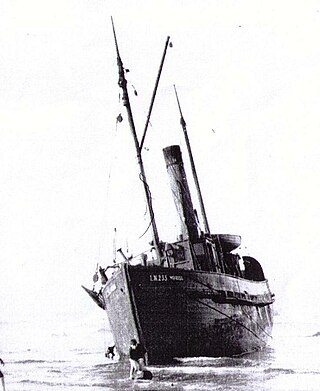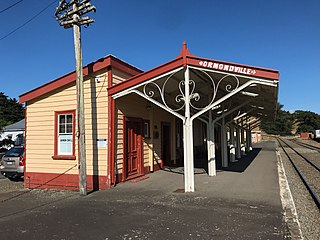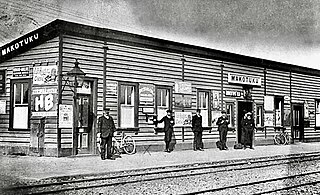Locomotives of New Zealand is a complete list of all locomotive classes that operate or have operated in New Zealand's railway network. It does not include locomotives used on bush tramways.

Muriel was a New Zealand fishing trawler that was built in 1907 by Messrs Lane & Sons of Totara North. In 1937, Muriel stranded on Sumner Bar at Christchurch, New Zealand, and was a total loss.

TSS Arahura was a twin screw steam passenger/cargo ship built for the Union Steam Ship Company. It was launched on the Clyde on 25 March 1905 and built by William Denny and Brothers Dumbarton at a cost of £52,000. It had a gross weight of 1,607 tons. The ship had accommodation for 201 passengers.

Pencarrow Head, also known as Pencarrow, is a headland in the Wellington Region of New Zealand and the name of the surrounding area, which was derived from Pencarrow, the family home of New Zealand Company director, Sir William Molesworth. The name is Cornish and formed from Pen which translates to English as head and Carrow which is a valley.

Koputaroa railway station was a station at Koputaroa in Horowhenua District on the North Island Main Trunk in New Zealand.

Longburn railway station was a station in Longburn, on the North Island Main Trunk in New Zealand. The platform, which is across from the Fonterra Factory, remains but the structure has been demolished.

Awapuni railway station was a station in Kairanga County, on the Foxton Branch and, from 1908, the North Island Main Trunk in New Zealand, now in the Palmerston North suburb of Awapuni. It was beside the Mangaone Stream, near its confluence with the Kawau Stream, about 400 m (440 yd) west of Maxwells Line on the north side of Pioneer Highway. Nothing remains of the former station, except a wide verge, partly occupied by a cycleway, built in 2015.

Greatford railway station was a station on the North Island Main Trunk (NIMT) in New Zealand, south of Marton. It is in the Manawatū-Whanganui region. Only a substation and a passing loop remain.

Feilding railway station was a station on the North Island Main Trunk line in Feilding, New Zealand. It was opened on 1 October 1876 and closed on 25 June 2012. The station is now used by Feilding Information Centre and an occasional excursion train.

Marton railway station was a station and rail junction on the Marton–New Plymouth Line, opened on 4 February 1878. After the North Island Main Trunk (NIMT) made a junction to the south of Marton, a new station was built there and the old station renamed and downgraded, in 1898.

Ormondville is a locality in the Manawatū-Whanganui region of New Zealand's North Island. It is located inland, south of Waipukurau and west of Flemington, Hawke's Bay.

SS Hilonian was a general passenger and cargo steamer, built as the Triumph in 1880 at Middlesbrough for McIntyre & Co, and later fitted with refrigeration equipment and leased to Shaw Savill and the New Zealand Shipping Company. She sank and ran aground many times, the final sinking being by torpedo in 1917.

Phoenix Foundry, often printed as Phœnix, was an engineering company in Auckland from 1861 to 1952. By 1900 it was on the verge of bankruptcy, but also Auckland's largest engineering works, supplying a wide range of goods and often leading in the design of equipment used to exploit the country's resources, such as timber and flax mills, crushers for gold ore and locomotives, pumps, cement and gas works and steamers. The foundry started with engineer, George Fraser, and a handful of employees, but grew to employ hundreds and operated under several names, including Fraser and Tinne and George Fraser & Sons Ltd.

PS Governor Wynyard, was a small steam ship, the first to be built in New Zealand, and was launched in 1851. She was a paddle steamer schooner, built of pohutukawa, with kauri planks. In 1853 she left her Tamaki River service in Auckland and was sold in Melbourne in 1852 during the gold rush, but was soon serving as a ferry in Tasmania, until she had her primitive engines removed in 1858. She sprang a leak and became a beached wreck in 1873.
SS Tauranga was the first coastal trading steam ship to be built in New Zealand, though a harbour steamer, Governor Wynyard, had been built at Auckland in 1851.

SS Go Ahead was a twin screw-steamer, launched on the afternoon of Saturday 20 April 1867 by Seath and Connell, of Rutherglen, for the Clyde Shipping Company, with a plan to use her in New Zealand coastal trading. She had 30, or 35 hp (26 kW), high pressure engines, and tubular boilers from Campbell & Son's foundry.

Makotuku is a locality in the Manawatu-Whanganui Region of New Zealand's North Island, about 3 km2 (1.2 sq mi) west of Ormondville.

Karewa, is a small, 3.57 ha, predator free wildlife sanctuary in the Bay of Plenty. It is about 6 km (3.7 mi) off Matakana Island and administered by the Department of Conservation (DoC), with Ngāti Ranginui. Its main species are tuatara and flesh-footed shearwaters. A legend of Taurikura relates how the tuatara on Karewa are descended from a chief's errant daughter.

SS Wiltshire was a passenger ship built for the Federal Steam Navigation Company by John Brown's of Clydebank in 1912 to run between Britain, Australia and New Zealand. She was wrecked when she ran aground in 1922.



















